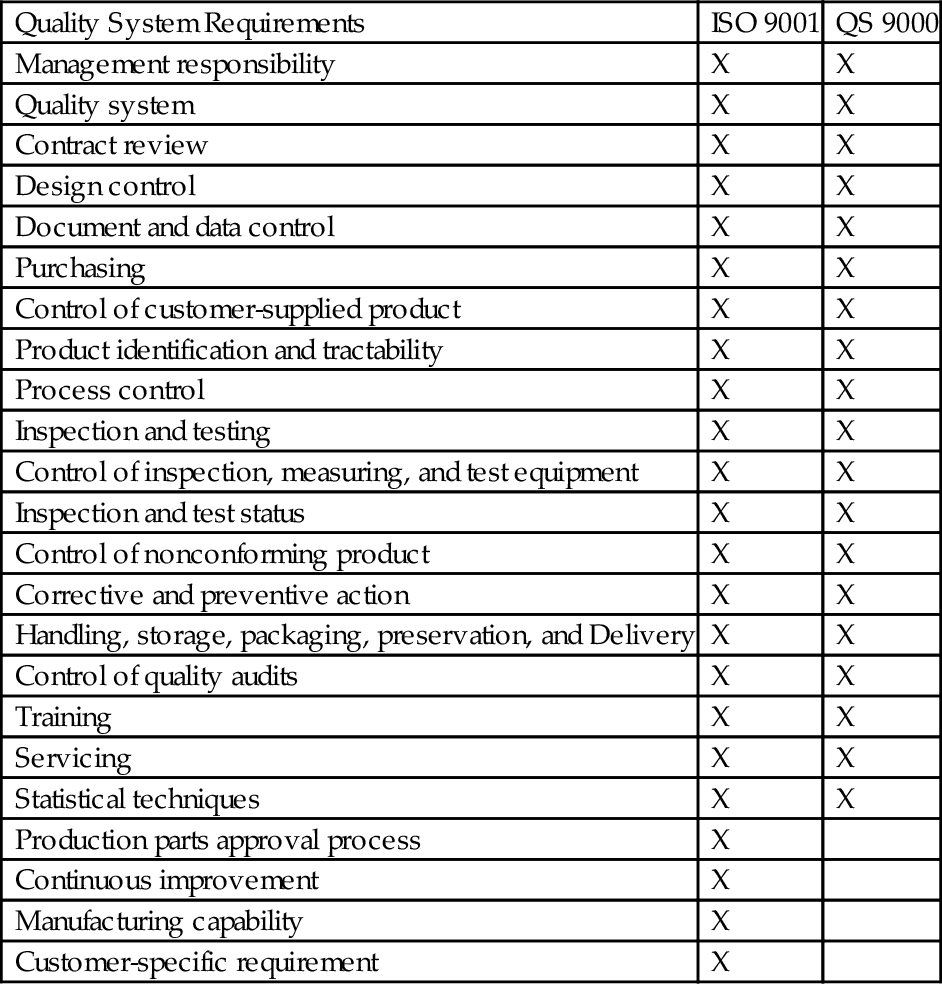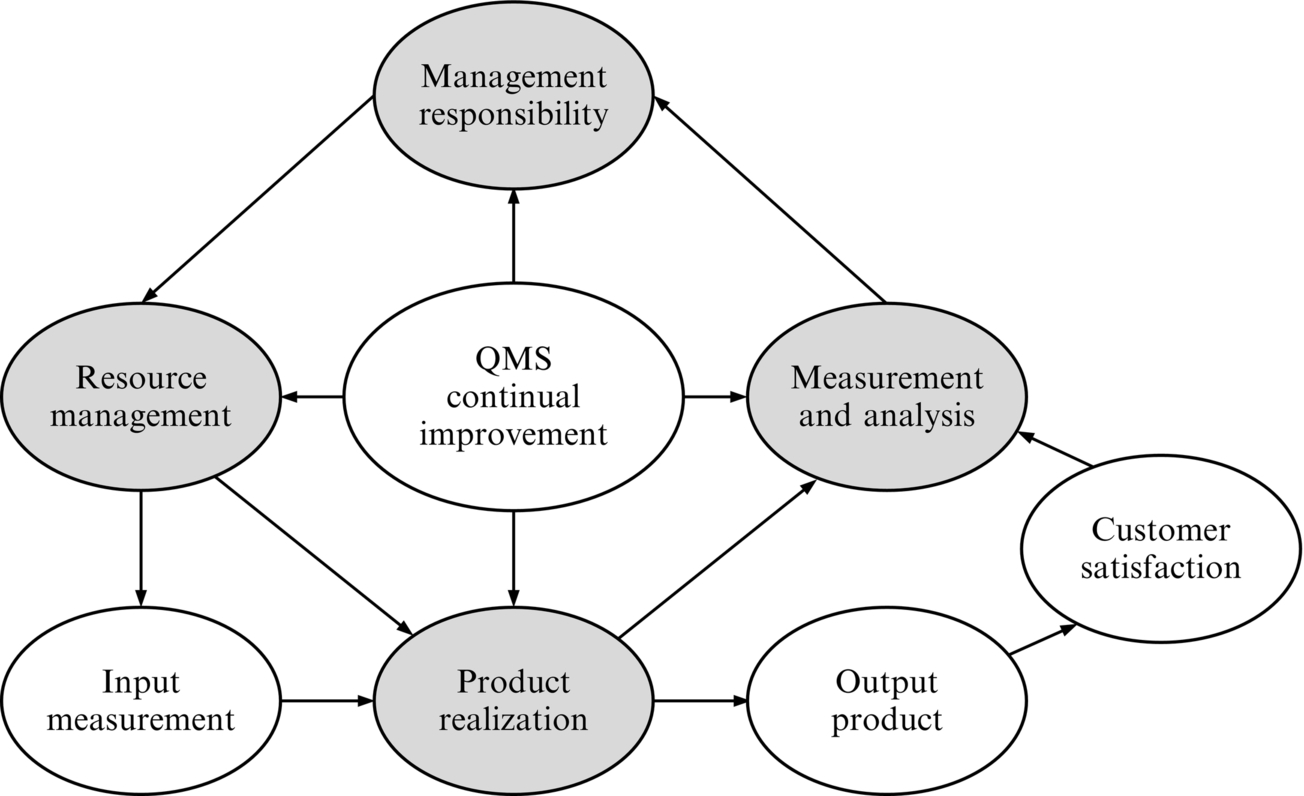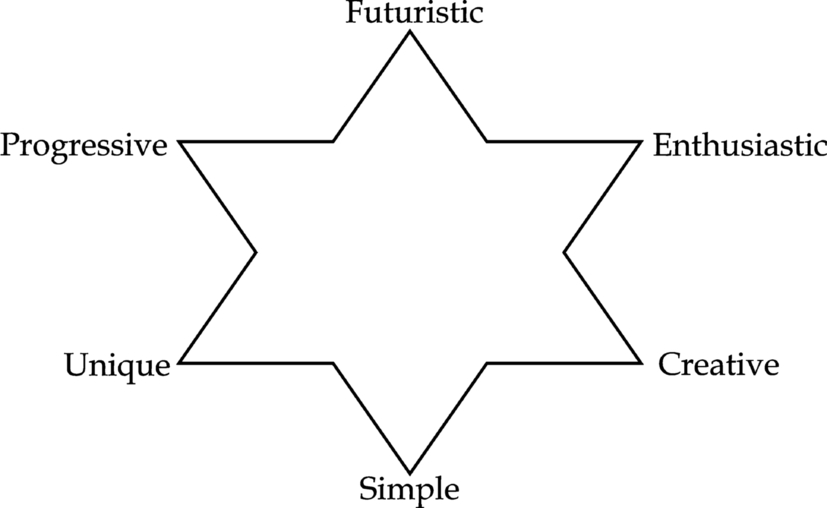ISO 9000 Quality Systems
Abstract
Quality management has become a way of life in the manufacturing sector, in fact in every sector, whether service, logistic, road building, or any other sector, and its importance is widely understood. Without a system in place to establish procedure, monitor progress, and evaluate performance, it is nearly impossible to consistently deliver a quality product to your customer. This calls for a quality management system for unified standards for evaluating the processes. This chapter traces the significant development of the ISO standards and explains the various requirements laid down by this series.
Keywords
Quality management systems; ISO; ISA; UNSCC; United States Department of Defense; MIL-Q-9858; NATO AQAP; BS 5179; BS 5750; ISO 8402; ISO 10000 series; ISO/TS16949QS-9000 series; Quality system requirements; Bureau of Indian Standards; Standard operating procedures; International Automotive Task Force
34.1 Need for Quality Management Systems
Quality management has become a way of life in the manufacturing sector, in fact, in every sector, whether service, logistic, road building, or any other sector, and its importance is widely understood. This calls for a quality management system for unified standards for evaluating the processes. Without a system in place to establish procedure, monitor progress, and evaluate performance, it is nearly impossible to consistently deliver a quality product to your customer. By utilizing quality management systems, problems are identified and corrected as they arise, allowing you to be proactive and minimize the likelihood of reoccurrence, which benefits all parties involved.
34.2 International Organization for Standardization
The International Organization for Standardization (ISO), its central office located in Geneva, is the world’s largest developer and publisher of international standards. It forms a platform for several countries to establish quality systems. It has a network of National Standards Institutes in 163 participating countries, including the Bureau of Indian Standards (BIS) of India. ISO standards are constantly advancing to meet the needs of growing sectors within the industry.
The vast majority of the ISO international standards are highly specific to product, material, and process, ensuring regulation from start to finish.
34.3 ISO 9000 Series of Quality Standards
The ISO 9000 family addresses various aspects of quality management and contains some of ISO’s best known standards. The standards provide guidance and tools for companies and organizations who want to ensure that their products and services meet customers’ requirements, and that quality is consistently improved.
34.4 Evolution of ISO 9000 Family of Standards
1926—Formation of International Federation of the National Standardizing Associations (ISA).
1944—Formation of United Nations Standards Coordinating Committee (UNSCC).
1947—Birth of ISO on the basis of the above two Associations.
1959—United States Department of Defense drafts MIL-Q-9858 standard.
1969—Revising the above into NATO AQAP series of standards.
1974—British Standards Institute adapts these into BS 5179 series of guidance standards.
1979—BS 5750 Part I, II, III series of requirement standards for system control in all areas of management which directly or indirectly affect quality.
1987—ISO 9000 family of Standards by ISO.
1988—Bureau of Indian Standards IS 4000 series.
1994—First Revision of ISO 9000 series.
In 1987, ISO released ISO 9000, which deals with the fundamentals of quality management systems and also gives guidelines for selecting the standards.
Subsequent standards in the 9000 series were released as follows:
• ISO 8402:1994—Quality management and quality assurance—vocabulary
• ISO 9001:1987—Model for quality assurance in design, development, production, installation, and servicing. This basically is for companies and organizations whose activities included the creation of new products.
• ISO 9002:1987—Model for quality assurance in production, installation, and servicing has basically the same material as ISO 9001, but without covering the creation of new products. This is applicable to the organizations who manufacture, supply, and service products or services as per specifications given by the customer.
• ISO 9003:1987—Model for quality assurance in final inspection and test. This covers only the final inspection of finished product, with no concern for how the product was produced.
• ISO 9004:2009—Introduced in 2009, this focuses on how to make a quality management system more efficient and effective. This has seven sections, each giving guidelines on services, processed materials, quality improvement, project management, quality plans, etc.
• ISO 19011:2011—Introduced in 2011, this sets out guidance on internal and external audits of quality management systems.
• ISO 10006—Quality management—guidelines for quality management in projects
• ISO 10007—Quality management—guidelines for configuration management
• ISO 10012—Quality assurance requirements for measuring equipment
• ISO 10013—Quality management—guidelines for developing quality manuals
• ISO 10014—Quality management—guidelines for economic effects of quality
• ISO 10015—Quality management—guidelines for continuing education and training
These standards have been revised periodically, in 1994, 2000, and 2008. The next revision was due in Dec. 2015.
It may be of interest that during mid-2015, American Society of Quality (ASQ) had initiated a blog on the LinkedIn website, where several interested professionals, including this author, could contribute their opinions on this revision. ISO did revise this standard in November 2015, which is further detailed in Section 34.17.
34.5 ISO/TS16949
The ISO/TS16949 is a process-oriented approach to the technical specification aiming at the development of a quality management system that provides for continual improvement, emphasizing prevention of defects and reduction of variation and waste in the supply chain. It is based on the ISO9001, but developed by International Automotive Task Force (IATF) with the key requirement of fulfillment of customer-specific requirements, set up by the automotive manufacturer in addition to the quality management system of their suppliers.
34.6 QS-9000 Series
QS-9000titled Quality System Requirements is similar to ISO-9000, International Quality System Standard, interpreted by US automotive giants Chrysler and Ford, applicable particularly to the US automotive industry, but now adapted world over. QS-9000 is made up of all the three sections: an ISO-9000 based requirement, a sector-specific requirement, and a customer-specific requirement. These requirements ensure that each supplier procures a good quality product. Furthermore, by developing QS-9000, we will be able to improve our product, customer satisfaction, and supplier relations as well.
Similarly:
(a) AS 9000, TL 9000, and PS 9000, too, were adapted as industry specific interpretation of the guidelines applicable for the aerospace, telecommunication, and pharmaceutical industries, respectively.
(b) ISO 13485:2003 is the medical industry's equivalent of ISO 9001:2000.
(c) ISO/TS 29001 are quality management system requirements for the design, development, production, installation, and service of products for the petroleum, petrochemical, and natural gas industries.
The following table indicates the parameters covered by each of these two series:
| Quality System Requirements | ISO 9001 | QS 9000 |
| Management responsibility | X | X |
| Quality system | X | X |
| Contract review | X | X |
| Design control | X | X |
| Document and data control | X | X |
| Purchasing | X | X |
| Control of customer-supplied product | X | X |
| Product identification and tractability | X | X |
| Process control | X | X |
| Inspection and testing | X | X |
| Control of inspection, measuring, and test equipment | X | X |
| Inspection and test status | X | X |
| Control of nonconforming product | X | X |
| Corrective and preventive action | X | X |
| Handling, storage, packaging, preservation, and Delivery | X | X |
| Control of quality audits | X | X |
| Training | X | X |
| Servicing | X | X |
| Statistical techniques | X | X |
| Production parts approval process | X | |
| Continuous improvement | X | |
| Manufacturing capability | X | |
| Customer-specific requirement | X |

34.7 Requirements as Specified by ISO 9000
1. Scope and purpose of the standard
2. Nomenclature reference such as ISO 9000:2008
3. Terms and definitions, for all items referred in the QMS
4. Requirement specifications as indicated in the table above
5. Documentation:
(a) Statement of quality policy, vision, mission, and quality objectives
(b) Quality manuals
(c) Procedure manuals
(d) Control documents
(e) Control records
B. Management responsibility
(b) Customer focus
(c) Quality policy
(d) Organization
(e) Responsibility and authority
(f) Communication—internal and external
(g) Delegation of management responsibility, specifying the duties, responsibilities, and authority
(h) Management review
C. Resource management
● Competitive
● Awareness
● Training
(b) Infrastructure
(c) Work environment
D. Product realization
(b) Planning the process
(c) Procedure followed for QFD
● Determination of requirement of procedure
● Review of requirement
● Customer communications
(d) Design and development
● Review
● Verification
● Validation
● Control of design and development changes
(e) Purchasing
● Purchasing information
● Verification of purchased product
(f) Production and service provision
● Identification and traceability
● Customer priority
E. Control of marking and measuring devises (measurement, analysis, and improvement)
(a) Planning and measuring customer satisfaction
(b) Internal audit
(c) Marking and measuring the process parameters
(d) Marking and measuring the products and services
(e) Control of nonconforming products
(f) Analysis of the data
F. Contractual improvement.
Fig. 34.1 illustrates relationship among the quality management systems (QMS) requirements as specified in ISO 9000.

34.8 Bureau of Indian Standards
BIS was originally established in 1947 as Indian Standards Institution to fulfill the role of standardization in gearing industry to competitive efficiency and quality production. On Apr. 1, 1987, it became BIS as a statutory body. BIS started the QMS certification as per ISO 90001.
34.9 Vision and Mission Statement
In today’s competitive environment, it is not enough for an enterprise just to be a step ahead of others. They should advance by leaps and bounds. The first step in this advancement is the vision statement.
Vision is the basic requirement for an enterprise. It is reflected by your dream and creates a focus for the organization, inspires all stakeholders, and transforms the purpose into actions and draws people into the process of performance.
A vision statement helps the organization to focus on what is real as we go about doing our daily work and dealing with the day-to-day hassles that plague all organizations. Vision is set by the management with a foresight into the future, and states not only what the company wants to be in the near future, but also the avenues by which it aims to achieve this vision, generally in one sentence. A typical vision statement of an industrial organization can be cited as:
By the end of the decade, we shall be the industry leaders in the country, by doubling our turnover every fifth year through new products, market penetration, launching of new and contemporary products, and world-class customer service.
34.9.1 Characteristics of a Vision Statement
The characteristics of a vision statement are as follows:
1. It is based on what the organization shall strive for and achieve during the next 5–10 years.
2. This acts as lodestar to all stakeholders, so that they can orient their performance as a team toward achieving the vision.
3. It inspires and uplifts everyone involved in your effort.
4. It creates a commitment. Motivation and the drive for initiating the mission, objectives, projects, and tasks needed to realize the vision.
5. It is broad enough to include a diverse variety of local perspectives for example, but short enough to be easily understood and shared by members of the community.
Before finalizing the vision statement, sufficient time shall be allowed for brainstorming among participants and then categorizing the random thoughts to ensure a comprehensive and realistic vision statement (Fig. 34.2).

34.9.2 General Guidelines in the Formulation of a Vision Statement
1. The vision statement should be short and realistic to the present situation.
2. It should project the growth of the organization.
3. The intention in achieving the goal should be highlighted in the statement.
4. It should also reflect the value system that would be adapted for growth.
5. Total employee involvement shall be highlighted in the statement.
34.9.3 Extracts From Some of the Vision Statements of Famous Companies Are Illustrated in the Following Section
1. A computer on every desk—Microsoft.
2. To bring inspiration and innovation to every athlete in the world—Nike.
3. A computer in the hands of everyday people—Apple.
4. Helping investors help themselves—Charles Schwab.
5. Make people happy—Disney.
6. To provide access to the world’s information in one click—Google.
34.9.4 Seven Tips on How to Write the Business Vision Statement
http://www.graystoneadvisors.com/7-ways-create-inspiring-vision-statement suggests the following seven tips on how to write the business vision statement
2. Make it powerfully memorable
3. Keep in synch
4. Gain consensus
5. Make it achievable
6. Make it visible
7. Align with your goals
34.10 Mission Statement
A mission statement is a written declaration of an organization's core purpose and focus that normally remains unchanged over time (Business Dictionary).
34.10.1 Features of Mission Statement
A mission statement:
• Serves as filters to separate what is important from what is not,
• Clearly states which markets will be served and how,
• Communicates a sense of intended direction to the entire organization.
• Converts the broad dreams of your vision into more specific, action-oriented terms.
• Explains your goals to interested parties in a clear and concise manner.
• Enhances your organization's image as being competent and professional, thus reassuring funding sources that their investment was (or would be!) a smart choice.
A mission statement defines the company’s goals, ethics, culture, and norms for decision making. They highlight the company’s goals in three dimensions:
• what it does for its customers,
• what it does for its employees, and
• what it does for its owners.
A nonprofit mission is never static. Especially in the first years, an organization’s mission shifts and changes as the organization develops.
34.10.2 A Clear Mission Statement Would
The process of writing your mission statement is much like that for developing your vision statements. The same brainstorming process can help you develop possibilities for your mission statement. Remember, though, that unlike with vision statements, you will want to develop a single mission statement for your work. After having brainstormed for possible statements, you will want to ask of each one:
• Does it describe what your organization will do and why it will do it?
• Is it concise (one sentence)?
• Is it outcome-oriented?
• Is it inclusive of the goals and people who may become involved in the organization?
34.10.3 Five Steps for Drafting a Mission Statement
The website of bplans.com indicates the following five steps in drafting a mission statement:
1. Start with a market-defining story
2. Define how your customer’s life is better because your business exists
3. Consider what your business does for employees
4. Add what the business does for its owners
5. Discuss, digest, cut, polish, review, and revise
34.11 Objectives, Goals, and Action Plans
Vision and mission statements are followed by the statement of objectives, goals, targets, and action plans as illustrated in the Fig. 34.3 given in the following section.

34.12 SOP—Standard Operating Procedures
Standard operating procedures (SOP) are the instructions that cover operational parts. Initially, an SOP is based on army-wide publications and then modified to use local operating conditions and command policies as a guideline. The scope of SOP is extensive and varies. It provides the major instructions for all division elements of operational features.
In general, there are two formats for an SOP to follow:
• A format that publishes all comprising documents which details the function and the responsibilities of subordinate units.
• A format that is published as a basic document which includes general instructions to all units. This kind of format has specific instructions for each individual unit. It is more detailed and easier to use.
34.13 Specific Features of ISO 9004
ISO 9004:2009 is a guidance document for the sustained success of an organization with a quality management approach. It emphasizes the effectiveness and efficiency of a quality management system, and consequently the potential for improvement of the performance of an organization. The objectives of customer satisfaction and product quality are extended to include the satisfaction of interested parties and the performance of the organization. It spells out the benefits of ISO 9004 to self-assessment. In short, this standard provides the basic understanding of total quality management principles.
34.14 Steps to be Followed for Getting ISO Certification
(a) We must know the complete details of the work we are doing
(b) We must know our work Procedures in detail
(c) Our workplace must be neat and clean
(d) Everything must be attached with a label/tag/color along with its status, ie, for inspection/accepted/rejected/for rework, etc.
(e) All the inspection, measuring, and test equipment must be calibrated
(f) We must maintain records, wherever written in the work procedures
2. Study the standard and select the right standard
3. Define quality policy and quality objectives. Display at various locations, explain meaning/intent to all
4. Give training to each and every employee
5. Write work procedures giving details of all activities
6. Make changes in work “practices” wherever necessary
7. Conduct “Internal Audits” to find out whether work is carried out as per written procedures
8. Implement suggestions/observations of internal audit
9. Conduct an audit by external auditors
10. Implement suggestions received from them
11. For certification audit, call world-famous, well-known auditors for audit
12. Implement their suggestions
13. Achieve certification
34.15 Benefits of ISO 9001-2000 and TS 16949 Quality Systems
1. Improved communication at all levels.
2. Decreasing trend in rejections, reworks, and customer complaints.
3. Decreasing trend in inventories
• W.I.P.
• Finished goods
• Lead time reduction
4. Customer relation improvement. Trust/confidence enhancement.
5. Subcontractor relations improvement. Long-term association.
6. Improved housekeeping.
7. Improved contacts with overseas buyers.
8. People development.
9. Improved health of people.
10. Reduced rejection/rework.
11. Improved housekeeping.
12. Increased morale of the company.
13. Ensured quality and after sales service to customers.
14. Improved team work.
15. It saves cost by:
• avoiding unnecessary records
• monitoring processes
16. Opportunities for export market.
17. Due to increased confidence of customers in you, you get more and more orders.
18. Improved discipline in the organization.
19. Increased credit in the market.
34.16 ISO 9000:2005
ISO 9000:2005 defines eight quality management principles in the quality management approach for the sustained success of an organization
Principle 2—leadership
Principle 3—involvement of people
Principle 4—process approach
Principle 5—system approach to management
Principle 6—continual improvement
Principle 7—factual approach to decision making
Principle 8—mutually beneficial supplier relationships
34.17 2015 Revision of ISO 9000 Series
Subsequent to the publication of ISO 9001:2008 and ISO 9004: 2009, ISO's Technical Committee TC 176/TC has been developing new standards and periodically releasing the supporting documents, giving guidelines to the users. All ISO standards are reviewed every five years to establish if a revision is required to keep it current and relevant for the marketplace. ISO 9001:2015 is designed to respond to the latest trends and be compatible with other management systems, such as ISO 14001.
Accordingly, ISO had now revised the ISO 9000 Quality Management Systems, the world's leading quality management standard, which was last revised in 2008.
It may be noted that the ASQ initiated discussions on ISO 2015 on its Twitter and LinkedIn, ASQ during the mid-2015, when several professionals, including this author participated and discussed the benefits and limitations of the 20125 revision, a reference to which would yield several interesting criticisms. Wikipedia records that the number of standards released in this series increased from 409,421 in 2001 to 1,138,155 in 2014. While Chands is first with 297,037 certificates issued in 2010, India stands eighth with 33,250, and the United States stands ninth with 25,101 certificates.
34.18 The Six Stages of the Release of the 2015 Revision
In 2012, its silver jubilee year, ISO 9001 decided to create a new QMS model for the next 25 years, starting with the new QM principles. The revised standard ISO 9001:2015 was published by ISO on Sep. 23, 2015 in the stages as indicated in the following section:
1. The proposal stage commenced in May-Jun. 2012
2. The preparation stage commenced in Jun.-Oct. 2012
3. The Committee discussion commenced in Jun.-Sep. 2013
4. The enquiry and discussions stages went on until May-Oct. 2014
5. It was approved in Jul. 2015
6. Final standard text was released in Sep. 2015
34.19 Revision of ISO 9000 in 2015
The new version follows a new, higher-level structure to make it easier to use in conjunction with other management system standards, with increased importance given to risk. More information about the changes can be found in the news area. It is specifically intended to ensure that ISO continues to adapt to the changing environments in which the organizations operate.
More importantly, the structure and core terms were modified to allow the standard to integrate more easily with other international management systems standards.
The 2015 revision focuses on performance by combining the process approach with Plan-Do-Check-Act and risk-based thinking such as failure mode and effect analysis (FMEA), which are described more earlier chapters and other safety standards, such as ISO 13485 on Food Safety, or Aerospace.
We can summarize the key changes as:
1. Greater emphasis on building a management system suited to each organization’s particular needs.
2. A major focus is given on achieving value for the organization and its customers.
3. Revisions allow ISO 9001 to be more applicable by “service-based” organizations.
4. A requirement that those at the top of an organization be involved and accountable, aligning quality with wider business strategy.
5. Risk-based thinking throughout the standard, emphasizing the use of FMEA, and safety standards such as ISO 13485, makes the whole management system a preventive tool and encourages continuous improvement. Identification of risk and risk control is now a requirement.
6. Addresses supply chain management more effectively.
7. Less prescriptive requirements for documentation: The organization can now decide what documented information it needs and what format it should be in.
8. Alignment with other key management system standards through the use of a common structure and core text.
9. Is more user-friendly for service and knowledge-based organizations.
10. Use of simplified language and a common structure of terminology by standardizing core text, structure, and definitions, to help organizations using multiple management systems, such as those for the environment, health and safety, or business continuity.
34.20 Conclusion
ISO 9000 deals with the fundamentals of quality management systems, including the eight management principles. Over one million global organizations are independently certified for ISO standards, making ISO 9001 one of the most widely-used management tools in the world today. However, ISO itself does not certify organizations. The third-party certification bodies provide independent confirmation that organizations meet the requirements of ISO 9001. The specific point of interest with ISO is the periodic revisions made in the standards, the latest being of ISO 9000 in 2015, as discussed earlier.

